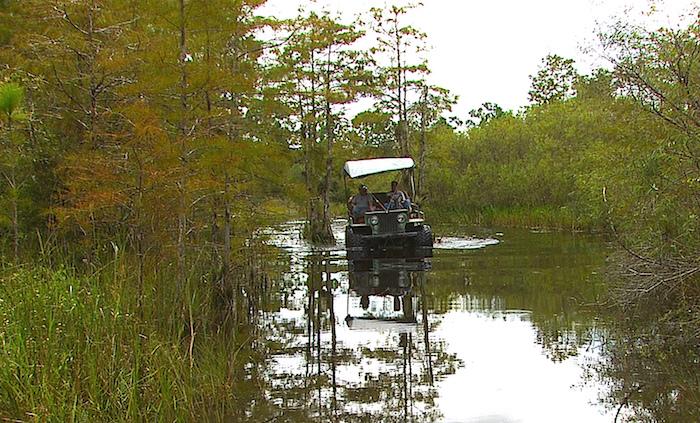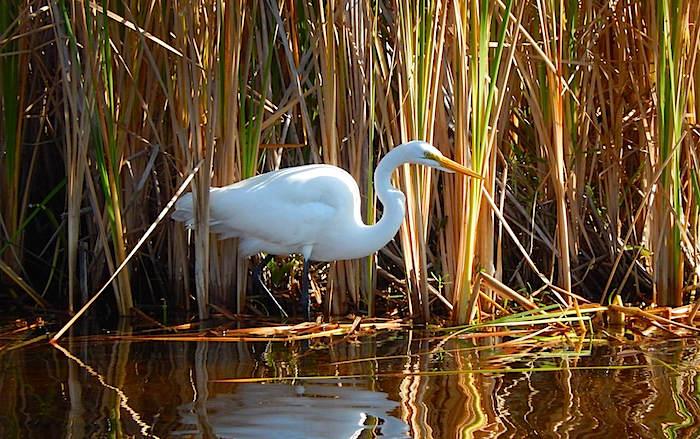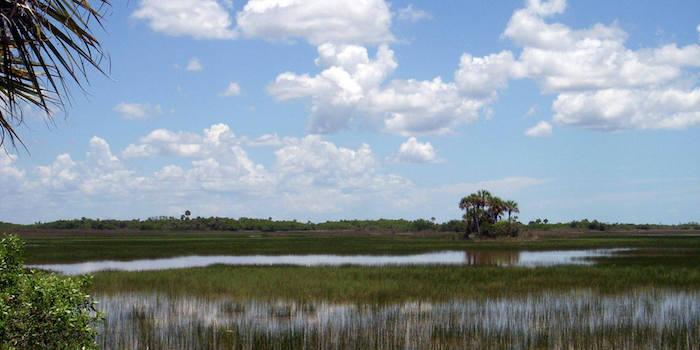
Conservation groups are concerned that National Park Service officials want more ORV use in Big Cypress National Preserve/NPS, via Elam Stoltzfus, Live Oak Production Group
An assessment of wilderness-quality lands in Big Cypress National Preserve in Florida demonstrates the National Park Service's desire to place off-road recreation above preservation in Big Cypress, according to conservation groups monitoring the process.
The Wilderness Eligibility Assessment released Monday by preserve officials not only falls short in identifying lands eligible for official wilderness designation, said John Adornato III, regional director of National Parks Conservation Association's Sun Coast office, but it also could be used to open up to ORV use areas that were placed off-limits by the preserve's 2000 ORV plan.
“I think that the Park Service has woefully underestimated the amount of lands in the original preserve that should be designated wilderness. It’s disappointing. The Park Service’s report is disappointing," Mr. Adornato said during a phone call. "The Park Service has chosen to prioritize off-road use over resource protection.”
At the South Florida Wildlands Association, Executive Director Matthew Schwartz said the assessment "opens up this whole possibility of secondary trails wherever anybody wants to go.”
"If you assume the definition that they’re using on secondary trails of going to any kind of destination -- a hammock, an area where you want to camp -- if they have no wilderness in there, they can go way off the ORV plan and just start running trails anywhere," Mr. Schwartz added during an interview. ”It’s very disappointing that they keep pushing for more and more access.”
National Park Service Director Jon Jarvis, who signed off on the report on June 18, was on vacation and unavailable for comment Monday, according to his staff. Big Cypress officials did not immediately respond to an email seeking further elaboration of the plan.
The assessment report, nine pages long, concludes that of the 557,065 acres assessed, 188,323 acres meet the eligibility criteria in the Wilderness Act of 1964 and NPS Management Policies. (Not included in the assessment was the 150,000-acre Addition Lands section of the preserve, which had a wilderness eligibility review as part of the management plan written for the area in 2010.)
How the National Park Service has approached wilderness eligibility and designation at Big Cypress, as well as ORV access, have been contentious issues almost from the time the preserve was established in the mid-1970s. Since an off-road vehicle plan was approved for the preserve in 2000, the topics have led to a regular parade to courts by organizations that think too much of Big Cypress is being given over to motorized recreation.
The Park Service has been sued for decisions concerning off-road vehicle access in landscapes considered to be key to more than a few plant and animal species listed as threatened or endangered. Foremost in this leafy and swampy wild kingdom is the Florida panther, which has been described as the most-endangered mammal in North America.

Florida panthers, Great egrets, and many other species of flora and fauna reside within Big Cypress/NPS
In July 2012 a federal court ruled the Park Service acted without sound reasoning in 2007 when it reopened more than 22 miles of off-road vehicle trails in the Bear River Unit of the preserve. In its ruling, the court ordered that the routes be closed. The ruling held that the preserve's superintendent in 2007, Karen Gustin, failed to adhere to the National Environmental Policy Act, the Endangered Species Act, the Administrative Procedures Act, violated past Executive Orders pertaining to off-road vehicles, the Big Cypress Establishment Act, the National Park Service Organic Act, and the preserve's 2000 ORV Management Plan adopted by then-superintendent John Donahue.
When he approved the 2000 ORV plan, Superintendent Donahue (now superintendent of Delaware Water Gap National Recreation Area) based his decision on biological information and suitability studies indicating that ORVs were damaging ecosystems and disturbing the Florida panther, an endangered species. That plan aimed to cut 23,300 miles of dispersed ORV trails in the preserve down to just 400 miles of designated trails. In Big Cypress's so-called Bear Island Unit, that plan called for a reduction of 55 miles of primary trails to just about 30 miles of primary trails and an unspecified amount of secondary routes.
While environmental and conservation organizations in 2011 again sued the Park Service over how much official wilderness and how many miles of ORV trails it would allow in the 150,000-acre Addition Lands section added to the preserve in 1996, a judge last fall upheld the Park Service's position, ruling that it could place recreation over resource preservation. U.S. District Judge John Steele ruled that Big Cypress officials both correctly analyzed the Addition Lands for wilderness eligibility and were within the law and not motivated by politics when they decided to remove 40,000 acres from wilderness consideration.
The overarching legal principles Plaintiffs seek to establish are simply not that easy. The conservation mandate of the NPS Establishment Act was tweaked by the subsequent Preserve Act and the Addition Act, both of which required multiple use management, which included the allowance of hunting and at least some recreational ORV use. As was previously stated, multiple use management is 'a deceptively simple term that describes the enormously complicated task of striking a balance among the many competing uses to which land can be put.' The Court rejects Plaintiffs' argument that every NPS decision must favor preservation if there is a conflict with another goal. This would not be 'striking a balance.' The Court finds that the substantive decisions by the NPS did not violate the Organic Act or the Establishment Acts.
That ruling is being appealed by NPCA.
Big Cypress officials' intentions to hold public meetings this summer to take input on their Backcountry Access Plan has drawn concerns from NPCA and the South Florida Wilderness Association that ORV access will be expanded in the preserve, including to some areas placed off-limits by the 2000 ORV plan.
"Most of what is in (the Wilderness Eligibility Assessment) as eligible is basically what we expected, but there are two very clear ways that the Park Service has chosen recreation over preservation in this report," Mr. Adornato said. "One is that they leave open the heart of the preserve without any wilderness. And the other is that they have eliminated wilderness designation, or chosen not to propose wilderness, in areas where they want to have off-road vehicle trails and where the off-road vehicle community wants access.”
The NPCA official pointed out that the wilderness assessment removes from potential wilderness designation areas closed by the 2000 ORV plan, closures upheld by the courts in 2012. The wilderness assessment even "draws those trails in on the map," he said. "It’s a clear indication that the Park Service is using not only the wilderness report but the Backcountry Access Plan as a means to get around both the 2000 plan, the court decision, and their responsibility to protect this resource.”
Mr. Schwartz pointed to maps included with the assessment that show how the Bear Island Unit in the preserve's upper northwestern corner was creatively carved up to exclude from wilderness eligibility areas proposed for secondary ORV trails.
It was Mr. Schwartz's organization that successfully challenged Big Cypress's approval of secondary trails. As part of a settlement of that lawsuit last September, the Park Service agreed to "leave all secondary off-road vehicle trails closed until further environmental review and analysis can be completed."
"The judge in this case spoke clearly in May of the need to complete further environmental analysis of the secondary trails. We are listening to the judge and will be investing all of our effort to complete this process as expeditiously as possible," former Superintendent Pedro Ramos said at the time. "My expectation is that the outcome of the analysis will help to permanently define secondary trail locations in both, the Addition Lands and the Original Preserve, in a manner that will balance preservation and traditional access into the preserve as our legislation directs us to."
Mr. Ramos currently is superintendent of adjoining Everglades National Park.

Some prairie areas of Big Cypress are suitable for wilderness designation, NPCA officials believe/NPS



Comments
There's nothing in the original enabling legislation for the Preserve or the Addition Lands that speaks to former Superintendent Ramos' assertion that the NPS is to "balance preservation and traditional access into the preserve." He misreads the law and, unfortunately so did the judge in the recent case, which I expect will be overturned upon appeal. For those interested, the legislation is at http://www.nps.gov/bicy/learn/management/upload/Enabling%20Legislation.pdf. Clearly the mandate is multiple use, but the overriding purpose as described in Section 4 is that the "lands shall be administered by the Secretary as a unit of the National Park
System in a manner which will assure their natural and ecological integrity in perpetuity in accordance with
the provisions of this Act and with the provisions of the Act of August 25, 1916 [i.e. the NPS Organic Act]."
I don't get how the NPS regional office or Washington office have supported the flip flopping of positions from Superintendent to Superintendent at Big Cypress. Now that Mr. Ramos has been rewarded by being promoted to Superintendent of Everglades, I fear for the future of that park, too.
Nice job Kurt on a very complex issue. Some thoughts. The first litigation in the Big Cypress on the off-road vehicle issue was launched in 1995 by the Florida Biodiversity Project. At that time, there were no limitations on the number of vehicles accessing the preserve - or where they could go. With the principles of the Organic Act of 1916 in mind, the National Park Service settled that lawsuit almost immediately and agreed to the writing of an "Off-Road Vehicle Management Plan" for the preserve. The plan was to regulate the use of vehicles in the preserve so as to protect the rare and sensitive natural resources of the Big Cypress (as well as the experience of the preserve for the many non-motorized visitors) - while still providing motorized access. The plan was finalized in 2000. Now, 15 years later, the National Park Service is still struggling to find the proper balance between motorized and non-motorized areas - and protection vs. motorized access. A big part of the problem is that every time the National Park Service has limited access (e.g. all marl prairies in the preserve will be closed to recreational vehicles due to damage to the sensitive substrate - ORV Management Plan of 2000) - another NPS administrator comes along with a different point of view. In fact, a great deal of land NPS found not to be eligible for wilderness in this go round are actually wet prairies and marshes - according to NPS's own science, the most unsuitable substrates in the preserve for motorized use.
As a result of NPS planning (with an enormous amount of public participation from all sides) and two successful lawsuits by environmental NGOs, the current trail map for off-road vehicle use in the preserve is pretty much the same as the map found in the Off-Road Vehicle Management Plan of 2000. It would be great if we could have finalized that map instead of embarking on a whole new "Back Country Access Plan" - and used an already existing ORV trail layout that provides for both motorized and non-motorized use throughout most of the preserve. That would be in line with the settlement of the 1995 lawsuit, and virtually all NPS legislation and policy which stresses that protection of natural resources takes precedence over recreational use. And all of us engaged in this seemingly endless and exhausting battle can move on to better and more enjoyable ways to spend our time.
Matt Schwartz - South Florida Wildlands Association
Due to Federal single species management thrust upon all of South Florida below lake Okeechobee that benefits one species alone (panthers) many many other wildlife populations are plummeting as uncontrolled Apex as well as other predators eat the other animals down there. Most of that in my view is due to a Federal agency being in charge that is vulnerable to extremist litigation for the last 15-20 years thwarting reasonable ORV access to most of Big Cypress which allows those who care to be the eyes and ears to help managers.. In view of that my opinion is that the Big C is really being managed by litigation results rather than professionals from State or Federal agencies. The best scenario for wildlife is for the State to engage the revertor clause in Florida law that will allow the State to take jurisdiction away from NPS in Big Cypress not because they are bad managers but due to Florida's flora and fauna suffering from endless NPCA style litigation induced mis-management. This revertor clause is a fact although few are aware of it - Will it Happen - Anybodies Guess! The really big issues in Big Cypress are much deeper than Wilderness at this point. Wilderness is just a sexy issue corporate environmental groups like NPCA and others can use to milk more donations from members informed with a bias twist by the groups leaders who are making big bucks off their backs..